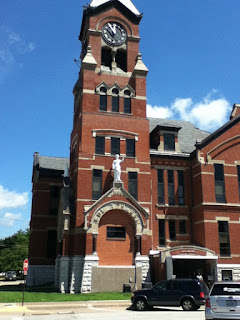As Ben Kaplan (cited below) points out, Washington has grown in recent decades, but slowly, enabling it to retain its older development pattern. Its population in 1940 was 5227, not much smaller at the time than the Chicago suburb where I grew up. But while my former town has grown by a factor of 8 since then, with sprawling subdivisions surrounding what had been a compact, walkable core, Washington's population has increased less than 50 percent, to 7266 in the 2010 census.
Doubtless there were people in Washington who wished their town had grown like topsy (or like Ben's counter-example of North Liberty, Iowa). But for whatever reason--revolutionary changes in agriculture, no nearby large city to become a suburb to--it didn't happen, and now Washington is well-positioned to be a pleasant, charming, financially resilient small town. Ben summarizes:
Washington, Iowa works as well today as it did in 1915, because it was designed on a human scale, is easy to navigate on foot, and it has a downtown that offers something for everyone.... A person could leave their house in Washington, walk downtown, get lunch, go to the library, spend the afternoon reading in the park, go shopping, and walk home and they would walk a shorter distance than it would take just to walk from [a typical home in North Liberty] to get to one strip mall.... Communities across the country have realized that building urban places, places that work the way Washington works, are a better way forward than continuing to build sprawl.(I will confess to being unclear as to the source of Washington's prosperity. It's neither a college town like Decorah, nor a tourist mecca like the Amanas, nor the seat of a corporate empire like Bentonville, Arkansas. It is the county seat of Washington County, and one of the state's largest casinos is nearby, but neither seems fully able to account for the good shape it's in. Whatever the source of its success, my argument is that its traditional, compact, walkable pattern of development will improve its chances of sustaining it.)
Downtown Washington is centered on a park, around which are various shops that open to the sidewalk. The buildings are old; the sidewalk is new.
The Coffee Corner is, appropriately, at the corner of Marion Avenue and Washington Street.
Down Washington Street, directly across from Central Park, is the public library. It was rebuilt in 2009, but in its previous space and in a way that blends in with the surrounding, older architecture. (Ditto the Washington National Bank building at the corner.)
Central Park is entirely shaded, making it a convenient, comfortable place to relax even on the hot, humid day I visited.
It includes a Civil War memorial...
...and a statue of George Washington with a time capsule to be opened in the 2070s.
The business district extends for several blocks in each direction. This is not just a frou-frou façade, but the place where the real business of the town is conducted. That includes legal business, in the historic courthouse.
There are several downtown churches, as well, each built on the traditional model Gary Jacobsen calls "embedded" (The Space Between, Baker Academic, 2012, pp. 189-190):
 |
| First Christian Church, B Avenue and 2nd Street |
 |
| First Baptist Church, 2nd Avenue and 2nd Street |
The edge of the business district blends seamlessly into residential areas.
There is a mix of housing types in the blocks I walked. Most seemed in good repair; few were as cool as this one.
Recent downtown beautification efforts have worked with the walkable development today's Washington has inherited. I'm not entirely charmed by the results. The walkways through Central Park form a cross and a diamond. These lead to crosswalks mid-block, each clearly demarked by brick, but none at the corners. The sidewalks simply end across from the park.
The mid-block crosswalks aren't ideal, either. The streets around Central Park feature head-in angle parking on both sides of the street as well as two rows (one each way) in the middle of the street. This means there's plenty of parking, so stores and churches don't have to provide their own lots. With all the cars parked everywhere, though, it makes it hard to see into the intersection when crossing.
 |
| Crossing from park to the library from the vantage point of a 6 foot tall man |
...which, along all those storefronts, created their own dangers.
Which is merely to say that, Washington, despite its good start on the 21st century, doesn't have all the answers. But who does?
SEE ALSO
Ben Kaplan, "What is Urbanism?" We Create Here, 13 April 2015, http://www.wecreatehere.net/2015/04/13/what-is-urbanism/

















No comments:
Post a Comment